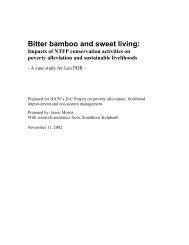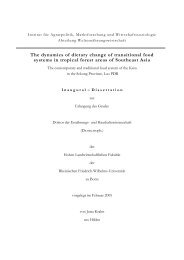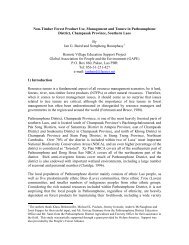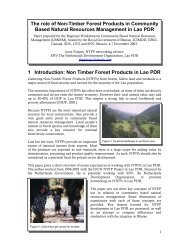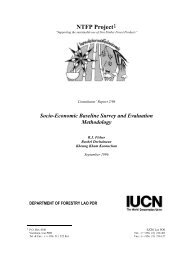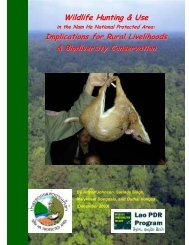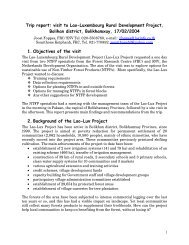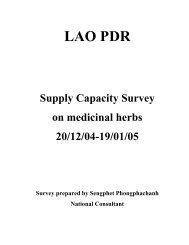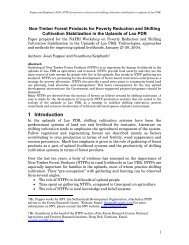Create successful ePaper yourself
Turn your PDF publications into a flip-book with our unique Google optimized e-Paper software.
5- According to a survey over 100 of 191 individual households, family ec<strong>on</strong>omies derived<br />
41% of their income from NTFP’s, 32% from livestock sales and 28% from other sources in<br />
1996. They spent 65% of their income <strong>on</strong> buying rice in 1996. These data differ from the<br />
outcome of the ranking exercise. Group discussi<strong>on</strong>s may underestimate the income from<br />
livestock. At any rate NTFP’s are by far the most important source of income in all villages.<br />
6- In a normal year like 1996, of all 191 families living in the 5 villages together, 108<br />
families or 57 % have a positive net income, and 83 families or 43 % had a negative income<br />
or rice shortage. Unprecedented floods destroyed most rice crops in the wet seas<strong>on</strong> of 1996,<br />
therefore most families must spend their entire income <strong>on</strong> buying rice in 1997. Many families<br />
will not be able to find enough m<strong>on</strong>ey to satisfy their needs in rice, even though they will sell<br />
more livestock and increase their collecti<strong>on</strong> of NTFP’s.<br />
7- Income from NTFP’s is higher am<strong>on</strong>g wealthy families than am<strong>on</strong>g poor families.<br />
However, in poor families NTFP’s are often the <strong>on</strong>ly source of income, as they do not have<br />
access to other opti<strong>on</strong>s such as livestock raising, salaries or trading (see table A).<br />
Table A: Average family income for 1996 am<strong>on</strong>g all 191 families in 5 villages <strong>on</strong> the<br />
<strong>Nakai</strong> <strong>Plate</strong>au, divided into four income groups.<br />
Income group Richest Medium Poor Poorest TOTAL<br />
No families 48 60 41 42 191<br />
NTFP's 99,740 107,555 60,461 70,487 82,926<br />
Livestock 152,220 41,500 73,462 3,900 64,914<br />
Off-farm 164,000 23,667 37,667 4,000 56,199<br />
GROSSVALUE 415,960 172,722 171,590 78,387 204,038<br />
Rice* -10,939 -30,936 -232,712 -294,634 -133,519<br />
NET VALUE 405,021 141,786 -60,273 -246,464 70,519<br />
*) Amount of m<strong>on</strong>ey needed to buy rice (negative values) or surplus rice sold (positive values), based <strong>on</strong> a<br />
calculati<strong>on</strong> of surpluses after family c<strong>on</strong>sumpti<strong>on</strong>, calculated as 300 kg/head/year.<br />
This finding has important implicati<strong>on</strong>s for the planning of all income generating and social<br />
activities in the resettlement scheme. Poor families are the most vulnerable when access to<br />
NTFP’s is going to be reduced by the inundati<strong>on</strong> of the former collecti<strong>on</strong> areas by the<br />
reservoir. Development agencies working with these families may want to develop special<br />
measures to counterbalance such losses.<br />
8- From the survey, kisi resin comes forward as the most important NTFP for income<br />
generati<strong>on</strong>, going up from 28% of NTFP based family income in 1996 to 56% of average<br />
family income in 1997 (see table B). Curiously rattan shoots have come up to sec<strong>on</strong>d place in<br />
1997, replacing b<strong>on</strong>g bark which has been greatly reduced. Rattan canes have all but<br />
disappeared, cardamom remains stable. Most of these products are sold through Takhek, the<br />
Provincial capital, except for rattan canes which are mainly exported to Vietnam via Laksao.<br />
9- Villagers estimate that 60 % of NTFP’s are collected from streams, p<strong>on</strong>ds, paddy fields,<br />
grass fields, and fallow fields, which are not strictly forest areas. These areas are likely to be<br />
mostly situated within the inundati<strong>on</strong> z<strong>on</strong>e. Only 25 % was said to be derived from evergreen<br />
forest and mountains. Only 16 % of all NTFP’s are said to be derived from the proposed<br />
resettlement area, called “pa kok” by villagers. It is also remarkable that little difference in<br />
opini<strong>on</strong> was found between groups of men and women <strong>on</strong> this issue.



